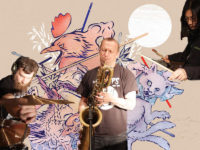Mats Gustaffson directs 28 of musicians on the four-part Enter, the Fire! Orchestra’s first studio album. Fire! originated as the trio of Gustafsson on saxophone, Johan Berling on bass guitar and Andreas Werliin on drums but, toward the end of 2011, the band was radically expanded.
Fire! now includes a mass of musicians around the central core of Sten Sandell on keys, Goran Kajfes on trumpet, Raymond Strid and Johan Holmegard on drums, David Stackenas on guitar, Fender Rhodes player Martin Hederos, electronicist Joachim Nordwall, and vocalists Mariam Wallentin, Sofie Jernberg and Simon Ohlsson. The newly renamed Fire! Orchestrea has played with various groups and ensembles, and are well known on the improv and jazz circuits. Gustafsson serves as musical director and manages, for the most part, to maintain a grip on things — whilst occasionally he can do nothing but allow the musicians involved to take the direction he offers and do with it as they will.
“Enter, Part 1” begins with vocals over the orchestra, as a repeating riff drives the music whilst the vocal ensemble soar over the top. The middle section starts with electronic noise, from which develops a powerful vocal solo with strong prog-rock influences — reminiscent of virtuoso vocal performances of the early ‘70s. This is not what the listener might expect from Gustafsson’s directorship, and maybe why the album inspired a couple of poor reviews. However, stick with it. By the end of the track, the sax enters and produces a load of free improve riffs which saves the side for free jazz addicts.
“Part 2” begins with a stonking riff ripped from the Beatle’s psychedelic classic “Tomorrow Never Knows,” then quickly ascends into mayhem as the orchestra join the vocalist and play with the riff — screaming, tweaking and tossing it around between them until it is only just recognizable. It develops its own life and midway through “Part 2” becomes something else. The orchestra simply makes it their own, devouring notes, riffs and any semblance of the original theme and developing their own electro-static take. It evolves into electronic noise, underpinned by occasional musical riffs and tones but largely it is musicians challenging, daring and experimenting. Then, suddenly all goes quiet, a morphing process takes place involving aggressive turmoil until the horns enter and establish dominance with an orchestral arrangement, which takes you by surprise.
Every musician contributes to what is, to all intents and purposes, a big band brass section — Disciplined, honed and completely tonal. By the end of the piece, however, all sense of orchestration has been taken over by improvised and free playing. It would not be Gustafsson, otherwise.
“Part 3” starts with silence interspersed with odd chuckles, clicks and various bird-like noises from the musicians, including some vocals which build slowly, very slowly until the theme develops with vocals over the orchestra — still making all kinds of quirky sounds. After a brief sojourn into what is almost a proper song, the orchestra takes over with more quirky, odd sounds — and then a full-on blast of several minutes full orchestra. The vocals here are truly amazing.
The final side begins with a Zeppelin-like ballad with vocals over a supporting orchestra. There is a definite tune here and the orchestra play like — well, like an orchestra, under full musical direction. And it keeps going, becoming a full-on prog rock ballad from the orchestra with amazing vocals, disciplined, coordinated playing. That is until around the 7 minute, 40 second mark when the musicians begin to go their own ways, like wayward children taking leave of their director — and they never stop. The track is allowed to evolve as the collection of great musicians take the tune and go off to play for about half a minute, when the distinctive riff which defines this side returns (it seems the rebels have been keel-hauled back to their director) and stays until the fade out.
Enter is noisy, experimental and brave. The listener is reminded at different points of prog rock, psychedelia, rock ballads, a dash of Nina Hagen in the vocals, early experimental jazz and heavy rock in turn. There is homage to Sun Ra — one of Gustafsson’s influences — and he uses free structure to build on the swing versions of the introduced set riffs on “Part 1” and “Part 4.” Enter contains a surprising amount of structure and big band elements, which is not how Mats usually presents his music but there is enough of Gustafsson’s bonkers style and take on things that his vision and musical strong direction impart something unique to the music.
It is, as I said earlier, not what you expect form Gustafsson, and yet it is — because nothing Gustafsson does is expected. Enter is a showcase of talent from a director who is still finding his musical feet, and will always push any boundaries as far as possible. Enter? If you dare.
- Luis Ianes and Noel Akchote – ‘Seuil’ (2025) - April 12, 2025
- David Dower Trio – ‘Sonder’ (2025) - March 23, 2025
- James McGowan Ensemble – ‘Reaching Out’ (2024) - December 18, 2024



